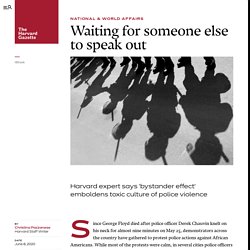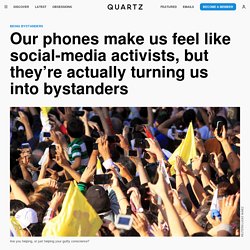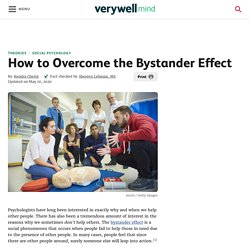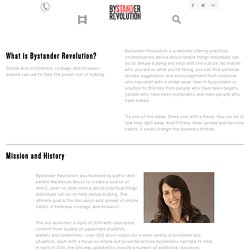

What is the bystander effect? Bystander Effect - IResearchNet. Bystander Effect Definition Individuals who see or hear an emergency (but are otherwise uninvolved) are called bystanders.

The bystander effect describes the phenomenon in which such individuals are less likely to seek help or give assistance when others are present. This does not mean that bystanders are apathetic to the plight of others, for bystanders often show signs of distress, anxiety, and concern if they delay responding or fail to respond at all. What Is the Bystander Effect? Bystander effect (video) From Empathy to Apathy. The Bystander Effect A Meta Analytic Review on Bystander Intervention in Dangerous and Non Dangerous Emergencies.
The Bystander Effect:The Death of Kitty Genovese. How the Death of Kitty Genovese Birthed 911 and Neighborhood Watches. The legacy of Kitty Genovese is grim and still resonates more than 50 years since her infamous murder.

Genovese, 28, was walking to her Kew Gardens, Queens apartment from her car when 29-year-old Winston Moseley stalked, attacked, raped and murdered her about 3:15 a.m. on March 13, 1964. Genovese had come home from working the late shift at a Queens bar and parked in the nearby Long Island Rail Road parking lot. She had only 100 feet to walk until she reached her door, located in an alleyway near the rear of the building, when Moseley approached her. He ran after the frightened woman and stabbed her twice in the back before she could reach the major thoroughfare of Lefferts Boulevard, just up the block.
“Oh my God, he stabbed me! Moseley ran away when one neighbor shouted “Let that girl alone!” “I had a feeling this man would close his window and go back to sleep, and sure enough, he did,” Moseley later said in court. 37 Who Saw Murder Didn't Call the Police; Apathy at Stabbing of Queens Woman Shocks Inspector. The man explained that he had called the police after much celiberation.

He had phoned a friend in Nassau County for advice and then he had crossed the roof of the building to the apartment of the elderly woman to get her to make the call. “I didn't want to get involved,” he sheepishly told the police. Six days later, the police arrested Winston Moseley, a 29year‐old business-machine operator, and charged him with the homicide. NYTimes KittyGenoveseArticle. The Bystander Effect. The Modern Bystander Effect. Police violence and the ‘bystander effect’ explained.
Since George Floyd died after police officer Derek Chauvin knelt on his neck for almost nine minutes on May 25, demonstrators across the country have gathered to protest police actions against African Americans.

While most of the protests were calm, in several cities police officers have used force against demonstrators and journalists under the justification of crowd control. The sight of officers in riot gear beating marchers, firing rubber bullets and chemical- or pepper-based irritants, and shoving activists has reignited questions about accepted practices in the nation’s law enforcement community. Francesca Gino, Tandon Family Professor of Business Administration at Harvard Business School, studies leadership, the psychology of decision-making, and organizational behavior. She has written about how an organization can develop a culture that can turn harmful to its own people, to the success of its mission, and to its own reputation. The bystander effect is being made worse by people filming violent events on their smartphones.
On April 9, 2017, a video of a man being dragged off a United Airlines flight was posted on the internet and went viral.

But I don’t need to tell you that. Each of your most outspoken Facebook friends probably posted about the event, highlighting the aspects of it that best reinforced their worldview. The incident was covered all over American media and even sparked outrage in China. The collective focus may have now moved on to its next source of outrage, but there was something that only a few people noticed in the moment: a plane full of quiet passengers. Other than one woman screaming, hardly anyone else on the plane seemed bothered enough by what was happening to raise a ruckus. Instead of intervening in the assault, the passengers stoically took out their cameraphones and pointed them toward David Dao, whose body was dragged along the aisle of the airplane, glasses askew, face bloody, and belly exposed. The Good Samaritan? George Floyd: How race may affect what bystanders can do for detainees. Surveillance video in Minneapolis shows the first moments of George Floyd's police interaction.

USA TODAY In the videos, they are faceless voices, off camera, trying to intervene. They say things like “get off his neck,” or “he’s a human,” or “he’s dying.” George Floyd, a 46-year-old black man, died Monday when a white Minneapolis police officer knelt on his neck for several minutes after he was detained. It was bystanders – the owners of those voices – who shed light with their viral video recordings of yet another deeply disturbing incident of excessive force levied against a minority in police custody.
As people in Minneapolis and across the U.S. continue to protest the killing, Floyd’s death has provoked even more questions about the role bystanders should play when caught in similar situations. History of complaints: Minneapolis police at center of George Floyd’s death had 13 combined complaints. The interaction between the bystander effects and social media. The bystander effect in rats. Abstract. Bystander Intervention Model. The bystander effect is complicated. How to Overcome the Bystander Effect.
Psychologists have long been interested in exactly why and when we help other people.

There has also been a tremendous amount of interest in the reasons why we sometimes don't help others. The bystander effect is a social phenomenon that occurs when people fail to help those in need due to the presence of other people. In many cases, people feel that since there are other people around, surely someone else will leap into action.1 While the bystander effect can have a negative impact on prosocial behavior, altruism and heroism, researchers have identified a number of different factors that can help people overcome this tendency and increase the likelihood that they will engage in helping behaviors.2 Some of these include: Witnessing Helping Behavior Sometimes just seeing other people doing something kind or helpful makes us more willing to help others. Imagine that you are walking into a large department store. Being Observant Being Skilled and Knowledgeable Guilt Feeling Good. Active bystander.
Helping Kids Overcome the Bystander Effect. Newscasters love to share stories of kids as young as three years old calling 911 to save a parent’s life.

These stories bear out what research has shown us: Very young children have a propensity to be kind and helpful. Starting as early as 18 months, studies show, toddlers spontaneously help an adult who is unable to pick up something he dropped or finds himself in a similarly tricky situation. Being kind at a cost to themselves makes two year olds happy, and three year olds who cooperate on a task share rewards even when they don’t have to.
But a recent study suggests that, like adults, kids are also subject to a major obstacle to helping: the bystander effect. Bystander Revolution. Simple acts of kindness, courage, and inclusion anyone can use to take the power out of bullying.

Bystander Revolution is a website offering practical, crowdsourced advice about simple things individuals can do to defuse bullying and help shift the culture. No matter who you are or what you’re facing, you can find personal stories, suggestions, and encouragement from someone who has dealt with a similar issue. Your Role in Preventing Sexual Assault. The only person responsible for committing sexual assault is a perpetrator, but all of us have the ability to look out for each other’s safety.

Whether it’s giving someone a safe ride home from a party or directly confronting a person who is engaging in threatening behavior, anyone can help prevent sexual violence. What is a bystander? A bystander is a person who is present when an event takes place but isn’t directly involved. Bystanders might be present when sexual assault or abuse occurs—or they could witness the circumstances that lead up to these crimes. On average there are over 293,000 victims (age 12 or older) of rape and sexual assault each year in the U.S.